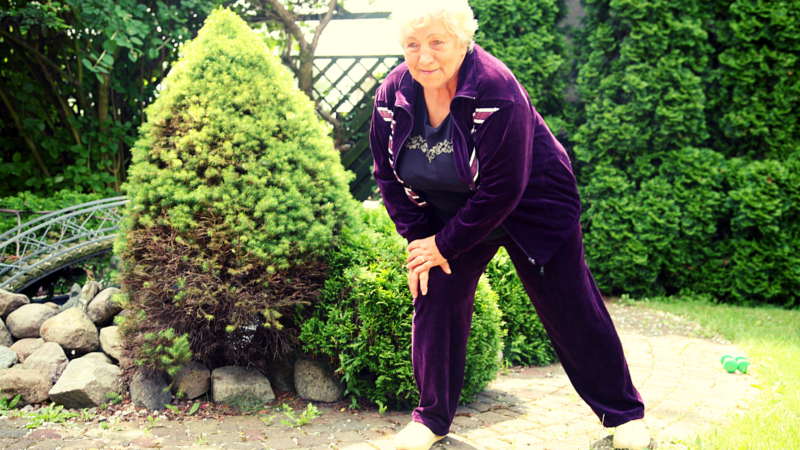The phrase “no pain, no gain” is often linked with intense workouts, especially made famous by 1980s action stars like Sylvester Stallone in Rocky Balboa.
But for seniors today, our understanding of pain in exercise has changed.
While a bit of discomfort can be a normal part of challenging your body, it’s important to know the difference between ‘good’ soreness and pain that could mean injury.
Let’s break down the truth behind “no pain, no gain” and the concept of ‘delayed onset muscle soreness’ (DOMS), especially for older adults.
Why exercise is so important for seniors
Exercise is essential for maintaining independence, mobility, and overall quality of life as we age.
Regular physical activity helps improve strength, balance, flexibility, and cardiovascular health, all of which are crucial for preventing falls, maintaining bone health, and managing chronic conditions like arthritis, diabetes, and heart disease.
For seniors, staying active also boosts mental health, improves sleep, and helps with energy levels.
The key to getting the most benefit from exercise is doing it consistently and at an appropriate intensity—challenging your body without overdoing it. This is where understanding “no pain, no gain” comes in.
While it’s important to push your body to improve, the aim is to do so in a way that’s safe and sustainable.
What is pain?
Pain is defined as “an unpleasant sensory and emotional experience” linked to actual or potential damage to tissues.
But pain is very individual. For instance, the pain from a paper cut is different from the dull ache of arthritis, and everyone experiences it differently.
When we exercise, pain can be a sign that muscles are being pushed beyond their usual limits, which is a normal part of getting fitter and stronger.

What is ‘delayed onset muscle soreness’ (also known as DOMS)?
After doing a new or intense exercise, many people feel muscle soreness that peaks 24 to 72 hours later. This is known as delayed onset muscle soreness, or DOMS.
DOMS happens when the muscles experience small tears, a normal part of the muscle-building process. As the body repairs these tiny tears, muscles become stronger and more prepared for the next workout.
While DOMS is a sign of improvement, it should be mild and manageable. If the soreness lasts more than a few days, or if there’s swelling, dark urine, sharp or severe pain that affects your movement, it could signal something more serious. In that case, you should see a doctor or physiotherapist.
The good and bad of ‘no pain, no gain’
So, when does soreness become more than just ‘good pain’? Here’s a simple guide:
- Good pain: Mild muscle soreness, fatigue, or a slight burning in muscles during or after exercise means your muscles are being challenged and will likely become stronger over time. This type of soreness usually goes away within a few days and is a normal part of exercise adaptation.
- Bad pain: Sharp, stabbing, or intense pain during or right after exercise is a sign of injury. If the pain doesn’t improve after a few days or if it’s accompanied by swelling, bruising, or difficulty moving, it may be a muscle strain or another type of injury that needs professional attention.
How to manage DOMS and stay active
If you’re experiencing mild soreness from DOMS, there are simple ways to manage the discomfort and speed up recovery:
- Warm up and cool down: A proper warm-up before exercise and gentle stretching afterward can reduce the severity of DOMS.
- Stay hydrated: Drinking plenty of water during exercise helps to flush out toxins and reduces muscle stiffness.
- Massage: A gentle massage around sore muscles, about two hours after exercise, can improve blood flow and ease discomfort.
- Take it slow: If you’re new to exercise or trying a new routine, start slowly. Overloading your muscles too quickly can cause excessive soreness or injury.
- Listen to your body: Don’t push through pain. If something feels too intense, ease off and focus on lower-intensity exercises until your body adjusts.
When to see a professional
If your soreness lasts longer than a few days or gets worse, it’s a good idea to see a healthcare professional. A physiotherapist can help determine whether your soreness is a normal part of recovery or a sign of something more serious.
For seniors, regular check-ins with an expert can help you stay on track with an exercise plan that’s both effective and safe.
Finding the right balance
There’s some truth in the saying ‘no pain, no gain’, but it’s important to apply it the right way – especially as we age.
For seniors, staying active is key to maintaining strength, mobility, and independence.
With the right approach, exercise can be both enjoyable and beneficial, and you don’t need to train like Rocky to see results. It’s all about consistency, gradual progression, and paying attention to how your body feels.
The Physio Co is committed to keeping you mobile, safe and happy. If you are interested in learning about the right type of exercises for you, please call us for more information.
Article written by Mike Quinn and Udari Colombage – TPC physiotherapists
Reviewed by Ella Le Hanie– Physiotherapist, 2024




 1300 797 793
1300 797 793